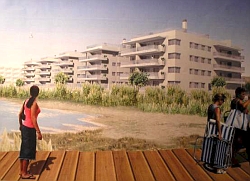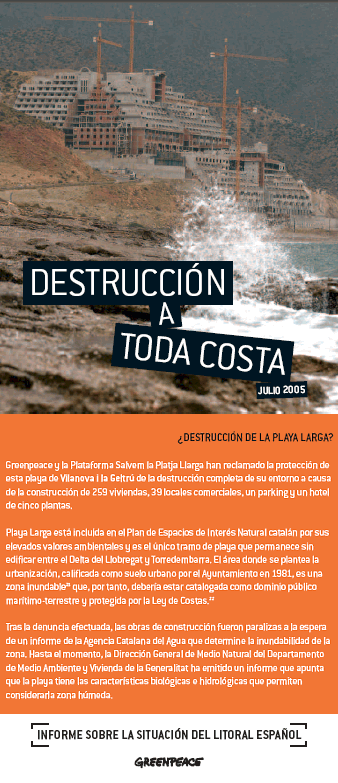When coastal development and conservation collide: Platja Llarga, Vilanova
There are economic benefits and environmental costs to coastal development which influence the success of the development equation. Platja Llarga at Vilanova, near Barcelona provides a rare case study where the costs were perceived to outweigh the benefits and coastal development pressures were blocked by local action.
 |
| Platja Llarga, Vilanova Barcelona (February 2008) |
Until 1881, Platja Llarga was a large area of coastal wetland and dunes, forming part of the delta of the River Foix. Today, although badly damaged, it remains one of the last undeveloped sites along the Catalan coast.
In June 2004, the local Vilanova i la Geltrú town council passed planning permission for the construction of 300 apartments and an hotel on the site, less than 30 metres away from the sea. The zone had been earmarked for urban development since the 1960s and according to the town mayor, "the Council acted properly". The planning process forced the promoter, Grup Subirats Berenguer, to replenish the beach, create a groundwater lake and build four breakwaters to protect the sand. The breakwaters required 50,000 tons of boulders, an expensive undertaking.
 |
| Planned Platja Llarga apartment blocks |

|
| Aerial view of the planned Platja Llarga development |
A local citizen's action group collected 5000 signatures to stop the development. The environmental campaign group Salvem la Platja Llarga helped coordinate the protest action with the support of Greenpeace. But it was a report from Dr. Maria Àngels Marquès, a professor in the Department of Geophysics and Geodynamics of the Faculty of Geology at the University of Barcelona, that won the day. Her study concluded that the Platja Llarga is a wetland zone "by virtue of low lying morphology and proximity to the sea". Building on such land would contravene planning laws.
Following Dr. Maria Àngels Marquès' work, a government report by the Directorate General Medi Natural de la Generalitat concluded that "in Platja Llarga there are natural areas that meet the biological and hydrological characteristics of wetlands." The report stated that "all wetlands must be preserved and protected from activities likely to cause recession and degradation."
With the breakwaters already constructed and the beach replenished, the town Council was forced to negotiate a way out with the promoter.
Platja Llarga will now be protected as an 'Espai Natural' (natural area) to provide a rare example of a traditional Mediterranean wetland and dune landscape.
 |
| A promenade extension along Platja Llarga was planned |
 |
| Greenpeace Platja Llarga action campaign |
|
Background to conflicts along the Catalan coastline
Urbanisation is almost continuous along the entire 672 kilometres of Catalan coastline. Between 1981 and 2001, the construction of houses along the coast grew at double the rate of population. The population increased by 36%, whereas the number of houses increased by 60.5%. Half of the houses are second homes, with the highest percentages in the Costa Dorada (71.3%), and the Costa Brava (64.6%). Saturation point has evidently been reached: there are now 75 coastal municipalities where practically 100% of the land is urbanised. In a further 30, the figure is 75%. Catalonia has one yachting marina for every 10 kilometres of coastline - which rises to one every 5 kilometres in the Costa Dorada. The Spanish Government is finally fighting back against the coastal concrete and its 'Strategy for Coastal Sustainability' (2007) aims to buy up unoccupied coastal land, recategorise as protected areas land already approved for construction, and demolish buildings and recreational ports that occupy public beaches. The plan also demands the enforcement of an existing law that requires the first 100 metres of shore be kept free of all construction. All in all, the proposal is expected to cost €5 billion and to affect more than 400 miles of coastline. New legislation in Catalonia has established a system of protection for non-urbanised land located within 500 metres of the sea in 50 coastal zones. This affects 23,500 hectares of coastline. |
Crowded Coasts
Els Muntanyans,
Torredembarra
